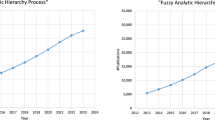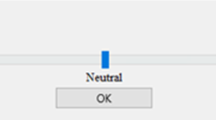Abstract
Fuzzy Analytic Hierarchy Process (Fuzzy AHP) has been widely adopted to support decision making problems. The Fuzzy AHP approach based on the synthetic extent analysis is the most applied approach to calculate the values of the criteria weights from fuzzy comparative matrices. The min operator is used to calculate the weights based on values of degree of possibility. If any of the degrees of possibilities is zero, the output of this operator will also be zero. Thus, the criterion weight or alternative score will be set to zero. If not prevented, this problem may lead to a distorted rank. Despite the fact that there are other propositions based on synthetic extent analysis method, none of the studies found in the literature investigate how the problem of null weights and scores can be avoided. This paper investigates different approaches of the Fuzzy AHP method to evaluate whether they can avoid the problem of null weights and scores without affecting the consistency of the results. Five different approaches based on synthetic extent analysis method were implemented and evaluated. Tests were performed considering 12 decision problems. The results indicated that the Fuzzy AHP approach proposed by Ahmed and Kilic is the most appropriate to overcome the problem of null weight of criteria and scores of alternatives without affecting the consistency of the results. Other benefits of using this approach are the simplicity of the computational implementation and better ability to differentiate the importance of the criteria when the weight values are very close.
Similar content being viewed by others
References
Ahmed F, Kilic K (2015) Modification to fuzzy extent analysis and its performance analysis. In: 6th international conference on industrial engineering and systems management (IESM), Seville, Spain
Banaeian N, Mobli H, Fahimnia B, Nielsen I, Omida M (2018) Green supplier selection using fuzzy group decision making methods: a case study from the agri-food industry. Comput Oper Res 89:337–347
Bulut E, Duru O, Keçeci T, Yoshida S (2012) Use of consistency index, expert prioritization and direct numerical inputs for generic fuzzy-AHP modeling: a process model for shipping asset management. Expert Syst Appl 39:1911–1923
Büyüközkan G, Cifçi G (2011) A novel fuzzy multi-criteria decision framework for sustainable supplier selection with incomplete information. Comput Ind 62:164–174
Calabrese A, Costa R, Menichini T (2013) Using fuzzy AHP to manage intellectual capital assets: an application to the ICT service industry. Expert Syst Appl 40:3747–3755
Chai J, Liu JNK, Ngai EWT (2013) Application of decision-making techniques in supplier selection: a systematic review of literature. Expert Syst Appl 40:3872–3885
Chang DY (1996) Applications of the extent analysis method on fuzzy AHP. Eur J Oper Res 95:649–655
Chen J, Hsieh H, Do QH (2015) Evaluating teaching performance based on fuzzy AHP and comprehensive evaluation approach. Appl Soft Comput 28:100–108
Cho J, Lee J (2013) Development of a new technology product evaluation model for assessing commercialization opportunities using Delphi method and fuzzy AHP approach. Expert Syst Appl 40:5314–5330
Choudhary D, Shankar R (2012) An STEEP-fuzzy AHP-TOPSIS framework for evaluation and selection on thermal power plant location: a case study from India. Energy 42:510–521
Das MC, Sarkar B, Ray S (2012) A framework to measure relative performance of Indian technical institutions using integrated fuzzy AHP and COPRAS methodology. Socio Econ Plan Sci 46:230–241
De Boer L, Wegen LVD, Telgen J (1998) Outranking methods in support of supplier selection. Eur J Purch Supply Manag 4:109–118
Duru O, Bulut E, Yoshida S (2012) Regime switching fuzzy AHP model for choice-varying priorities problem and expert consistency prioritization: a cubic fuzzy-priority matrix design. Expert Syst Appl 39:4954–4964
Fattahi R, Khalilzadeh M (2018) Risk evaluation using a novel hybrid method based on FMEA, extended MULTIMOORA, and AHP methods under fuzzy environment. Saf Sci 102:290–300
Fedrizzi M, Krejcí J (2015) A note on the paper “Fuzzy analytic hierarchy process: fallacy of the popular methods. Int J Uncertain Fuzziness Knowl-Based Syst 23:965–970
Gou J, Shen G, Chai R (2013) Model of service-oriented catering supply chain performance evaluation. J Ind Eng Manag 6:215–226
Goyal RK, Kaushal S (2018) Deriving crisp and consistent priorities for fuzzy AHP-based multicriteria systems using non-linear constrained optimization. Fuzzy Optim Decis Mak 17(2):195–209
Hatami-Marbini A, Tavana M (2011) An extension of the ELECTRE I method for group decision-making under a fuzzy environment. Omega 39:373–386
Heo E, Kim J, Cho S (2012) Selecting hydrogen production methods using fuzzy analytic hierarchy process with opportunities, costs, and risks. Int J Hydrog Energy 37:17655–17662
Ho W, Ma X (2018) The state-of-the-art integrations and applications of the analytic hierarchy process. Eur J Oper Res 267:399–414
Kabir G, Hasin MAA (2011) Comparative analysis of AHP and fuzzy AHP models for multicriteria inventory classification. Int J Fuzzy Logic Syst 1:1–16
Kabir G, Hasin MAA (2013) Multi-criteria inventory classification through integration of fuzzy analytic hierarchy process and artificial neural network. Int J Ind Syst Eng 14:74–103
Kahraman C (ed) (2008) Fuzzy multicriteria decision making-theory and applications with recent developments. Springer Science, Turkey
Kubler S, Robert J, Derigent W, Voisin A, Traon L (2016) A state-of the-art survey & testbed of fuzzy AHP (FAHP) applications. Expert Syst Appl 65:398–422
Kutlu AC, Ekmekçioğlu M (2012) Fuzzy failure modes and effects analysis by using fuzzy TOPSIS-based fuzzy AHP. Expert Syst Appl 39:61–67
Larimian T, Zarabadi ZSS, Sadeghi A (2013) Developing a fuzzy AHP model to evaluate environmental sustainability from the perspective of secured by design scheme—a case study. Sustain Cit Soc 7:25–36
Lee SK, Mogi G, Lee SK, Kim JW (2011) Prioritizing the weights of hydrogen energy technologies in the sector of the hydrogen economy by using a fuzzy AHP approach. Int J Hydrog Energy 36:1897–1902
Lima-Junior FR, Carpinetti LCR (2016) A multicriteria approach based on Fuzzy QFD for choosing criteria for supplier selection. Comput Ind Eng 110:269–285
Lima-Junior FR, Osiro L, Carpinetti LCR (2014) A comparison between Fuzzy AHP and Fuzzy TOPSIS methods to supplier selection. Appl Soft Comput 21:194–209
Mandic K, Delibasic B, Knezevic S, Benkovic S (2014) Analysis of the financial parameters of Serbian banks through the application of the fuzzy AHP and TOPSIS methods. Econ Model 43:30–37
Marttunen M, Lienert J, Belton V (2017) Structuring problems for multi-criteria decision analysis in practice: a literature review of method combinations. Eur J Oper Res 263:1–17
Mosadeghi R, Warnken J, Tomlinson R, Mirfenderesk H (2015) Comparison of fuzzy-AHP and AHP in a spatial multi-criteria decision making model for urban land-use planning. Comput Environ Urban 49:54–65
Paksoy T, Pehlivan NY, Kahraman C (2012) Organizational strategy development in distribution channel management using fuzzy AHP and hierarchical fuzzy TOPSIS. Expert Syst Appl 39:2822–2841
Pedrycz W, Gomide F (2007) Fuzzy systems engineering—toward human-centric computing. Wiley, New Jersey
Rostamzadeh R, Sofian S (2011) Prioritizing effective 7Ms to improve production systems performance using fuzzy AHP and fuzzy TOPSIS (case study). Expert Syst Appl 38:5166–5177
Roy T, Dutta RK (2018) Integrated fuzzy AHP and fuzzy TOPSIS methods for multi-objective optimization of electro discharge machining process. Soft Comput. https://doi.org/10.1007/s00500-018-3173-2
Shaygan A, Testik ÖM (2017) A fuzzy AHP-based methodology for project prioritization and selection. Soft Comput. https://doi.org/10.1007/s00500-017-2851-9
Taylan O, Bafail AO, Abdulaal RMS, Kabli MR (2014) Construction projects selection and risk assessment by fuzzy AHP and fuzzy TOPSIS methodologies. Appl Soft Comp 17:105–116
Ureña R, Chiclana F, Fujita H, Herrera-Viedma E (2015) Confidence-consistency driven group decision making approach with incomplete reciprocal intuitionistic preference relations. Knowl-Based Syst 89:86–96
Ureña R, Chiclana F, Melançon G, Herrera-Viedma E (2019) A social network based approach for consensus achievement in multiperson decision making. Inf Fus 47:72–87
Vinodh S, Ramiya RA, Gautham SG (2011) Application of fuzzy analytic network process for supplier selection in a manufacturing organization. Expert Syst Appl 38:272–280
Wang YJ (2018) Fuzzy multi-criteria decision making on combining fuzzy analytic hierarchy process with representative utility functions under fuzzy environment. Soft Comput 22(5):1641–1650
Wang Y, Luo Y, Hua Z (2008) On the extent analysis method for fuzzy AHP and its applications. Eur J Oper Res 186:735–747
Wang H, Bai H, Liu J, Xu H (2012) Measurement indicators and an evaluation approach for assessing strategic environmental assessment effectiveness. Ecol Indic 23:413–420
Wang X, Chang HK, Li D (2015) A case study of an integrated fuzzy methodology for green product development. Eur J Oper Res 241:212–223
Yadegaridehkordi E, Nasir MHNB, Noor NFBM, Shuib NLBM, Badie N (2018) Predicting the adoption of cloud-based technology using fuzzy analytic hierarchy process and structural equation modeling approaches. Appl Soft Comput. https://doi.org/10.1016/j.asoc.2017.12.051
Yazdani-Chamzini A, Yakhchali SH (2012) Tunnel boring machine (TBM) selection using fuzzy multicriteria decision making methods. Tunn Undergr Space Technol 30:194–204
Zadeh LA (1965) Fuzzy sets. Informat Control 8:338–353
Zarghami E, Azemati H, Fatourehchi D, Karamloo M (2018) Customizing well-known sustainability assessment tools for Iranian residential buildings using fuzzy analytic hierarchy process. Build Environ 128:107–128
Zhü K (2014) Fuzzy analytic hierarchy process: fallacy of the popular methods. Eur J Oper Res 236:209–217
Zimmermann HJ (1991) Fuzzy set theory and its applications. Kluwer Academic, Dordrecht
Acknowledgments
This work was supported by CAPES (Agency for supporting human resource development in high education institutions).
Funding
This study was funded by CAPES—Agency for supporting human resource development in high education institutions (Phd scholarship).
Author information
Authors and Affiliations
Corresponding author
Ethics declarations
Conflict of interest
The authors declare that they have no conflict of interest.
Ethical approval
This article does not contain any studies with human participants or animals performed by any of the authors.
Additional information
Communicated by V. Loia.
Publisher's Note
Springer Nature remains neutral with regard to jurisdictional claims in published maps and institutional affiliations.
Rights and permissions
About this article
Cite this article
Lima-Junior, F.R., Carpinetti, L.C.R. Dealing with the problem of null weights and scores in Fuzzy Analytic Hierarchy Process. Soft Comput 24, 9557–9573 (2020). https://doi.org/10.1007/s00500-019-04464-8
Published:
Issue Date:
DOI: https://doi.org/10.1007/s00500-019-04464-8








